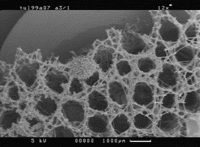Construction
Nature's simplest and most primitive multicellular animals are building truly massive reef structures and a complex seabed community.

The sponges that build the reefs are members of a special group of glass sponges that have a complex skeleton made of fused glass spicules. These skeletons provide the framework that allows multi year habitation of the reef sites by the sponges. The special ability of these sponges is that they can weld together in different ways so that from a living sponge to a dead and partly buried neighbour, a new outgrowth can grow and attach and stabilize the living sponge. Young sponge larvae attach to the skeletons of dead sponges, so that the old reef surface is the site of new sponge growth and so renewed reef growth. The sponges trap sediment and build up the mound slowly. When a sponge dies the skeleton is ultimately incorporated whole into the reef surface and trapping of sediments is reduced. When new sponges grow on the surface of the mound particle trapping begins again. As the sponges grow material becomes trapped in the frame of the sponge. The cycle of sponge growth then sediment trapping and ultimately death of the sponge may take many decades to complete. The sponges have been building the oldest and largest mounds for about 9,000 years.
